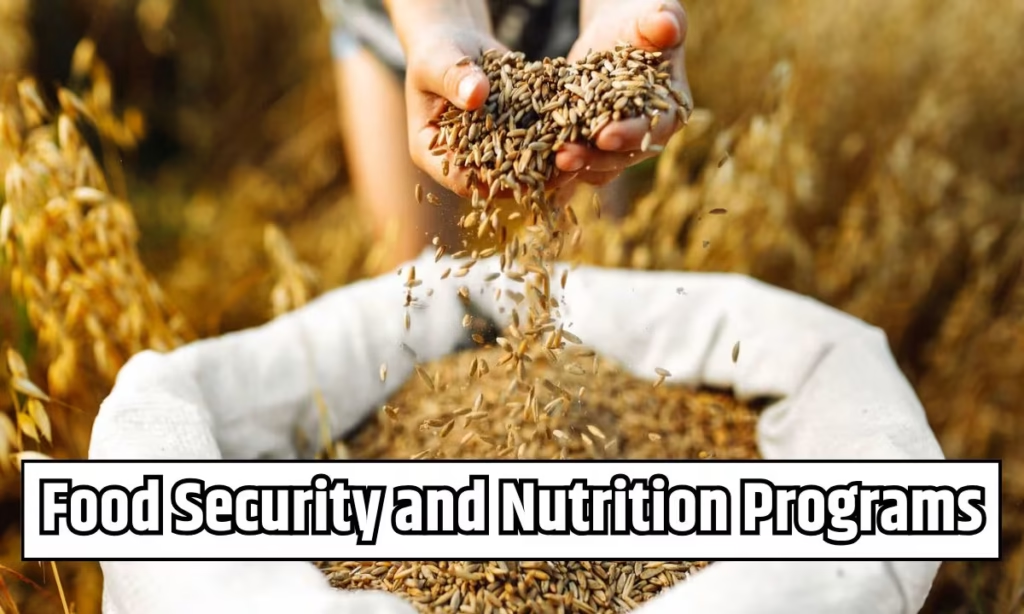Food Security and Nutrition Programs: In a world where nearly 800 million people go to bed hungry each night, the concepts of food security and nutrition have never been more critical. Imagine a child in a remote village unable to concentrate in school because of an empty stomach, or a family in a bustling city struggling to afford balanced meals amid rising costs. These scenarios highlight the urgent need for robust programs that ensure everyone has access to safe, nutritious food.
This blog post explores food security and nutrition programs, shedding light on their mechanisms, impacts, and future directions. Whether you’re a concerned citizen, a policymaker, or someone passionate about global health, understanding these initiatives can empower you to make a difference. We’ll break it down into simple, digestible sections to help you grasp how these programs are tackling one of humanity’s biggest challenges.
What is Food Security?
Food security is more than just having enough to eat—it’s about reliable access to sufficient, safe, and nutritious food that meets dietary needs and preferences for an active, healthy life. This definition encompasses four key pillars: availability (enough food produced), access (affordable and reachable), utilization (proper use through sanitation and knowledge), and stability (consistent over time despite shocks like disasters or economic fluctuations).
Globally, food insecurity affects billions, with factors like poverty, conflict, climate change, and inequality exacerbating the issue. For instance, in 2025, around 733 million people faced hunger, a number that’s stubbornly high despite progress in some regions. Malnutrition isn’t just undernutrition; it includes overnutrition leading to obesity, creating a “double burden” where countries battle both starvation and diet-related diseases simultaneously.
Understanding food security helps us appreciate why nutrition programs are essential. These programs bridge gaps by providing direct aid, education, and systemic changes to make food systems more resilient.
Why Nutrition Programs Matter
Nutrition programs are the backbone of efforts to combat food insecurity, focusing on delivering essential nutrients to vulnerable populations. Poor nutrition can lead to stunted growth in children, weakened immune systems, and long-term health issues like diabetes and heart disease. On the flip side, well-nourished individuals are more productive, contributing to economic growth and breaking cycles of poverty.
These programs matter because they address root causes. For example, they promote breastfeeding, which protects infants from infections and reduces obesity risks later in life—yet only about 44% of infants under six months are exclusively breastfed worldwide. By educating communities on balanced diets and fortifying foods with vitamins, these initiatives prevent micronutrient deficiencies like anemia, which affects 40% of young children and over a third of pregnant women globally.
In economic terms, investing in nutrition yields high returns. Every dollar spent on nutrition interventions can generate up to $16 in economic benefits through healthier workforces and reduced healthcare costs. As we face rising food prices due to inflation and supply chain disruptions, these programs become lifelines, ensuring that no one is left behind.
Major Global Food Security Programs
Around the world, organizations are stepping up with innovative programs to tackle food insecurity. The United Nations World Food Programme (WFP) is a frontrunner, delivering food assistance in emergencies and building long-term resilience. In 2024 alone, WFP reached over 124 million people across more than 120 countries, focusing on areas hit by conflict, disasters, and climate change. Their school feeding programs, for instance, provide meals to millions of children, boosting attendance and learning while supporting local farmers.
The Food and Agriculture Organization (FAO) of the UN emphasizes sustainable agriculture to enhance food production. Through initiatives like promoting climate-smart farming and reducing food waste, FAO helps countries build resilient food systems. Their annual State of Food Security and Nutrition in the World (SOFI) report tracks progress, revealing that in 2025, economic factors like inflation have made healthy diets unaffordable for billions.
The World Health Organization (WHO) integrates nutrition into health strategies, targeting issues like childhood obesity and micronutrient deficiencies. Their global action plans aim to reduce salt intake and eliminate trans fats, addressing the rise in non-communicable diseases linked to poor diets. Non-governmental organizations like Save the Children and Mercy Corps complement these efforts by working at the community level, identifying local causes of malnutrition and providing tailored solutions, such as agricultural training and emergency feeding.
The World Bank’s food security portfolio spans 90 countries, combining short-term social protection with long-term agricultural investments to combat food crises. These global programs often collaborate, as seen in the UN’s Sustainable Development Goal 2, which aims to end hunger by 2030 through improved nutrition and sustainable agriculture.
Key Nutrition Programs in the United States
While global efforts are vital, national programs provide targeted support. In the US, the USDA’s Food and Nutrition Service (FNS) oversees 16 programs that serve one in four Americans annually, partnering with states and tribes to boost food security. The Supplemental Nutrition Assistance Program (SNAP), formerly food stamps, helps low-income households buy groceries, reducing hunger and stimulating local economies.
The Special Supplemental Nutrition Program for Women, Infants, and Children (WIC) targets pregnant women, new mothers, and young children, providing nutritious foods, education, and healthcare referrals to prevent developmental issues. School meal programs like the National School Lunch Program (NSLP) ensure kids get balanced meals, improving academic performance and health.
Other US initiatives include the Emergency Food Assistance Program (TEFAP) for short-term relief and the Commodity Supplemental Food Program (CSFP) for seniors. States like Arizona enhance these with local twists, such as the Double Up Food Bucks program, which matches SNAP dollars for fresh produce at farmers’ markets. These programs not only feed people but also educate on healthy eating, aligning with broader goals to reduce obesity and food waste.
Challenges in Food Security
Despite advancements, food security faces formidable hurdles. Climate change disrupts agriculture through droughts, floods, and extreme weather, threatening crop yields and livelihoods. Conflicts displace millions, interrupting food supplies and increasing malnutrition risks—over 160 million children suffer from chronic malnutrition yearly.
Economic inequality widens gaps, with healthy diets becoming unaffordable due to inflation; in many countries, a nutritious meal costs more than a day’s wage for the poor. The COVID-19 pandemic exposed vulnerabilities, spiking food insecurity rates globally.
Urbanization and population growth strain resources, while food waste—about one-third of all produced food—wastes precious nutrients. Addressing these requires integrated approaches, from policy reforms to technological innovations like drought-resistant crops.
Innovations and Future Trends
The future of food security looks promising with emerging innovations. Precision agriculture uses AI and drones to optimize farming, reducing waste and increasing yields. Vertical farming in urban areas grows food efficiently with less water and land.
Biofortification enhances crops with nutrients, combating deficiencies in staple foods like rice and wheat. Digital tools, such as apps tracking food prices and donor platforms, improve transparency and aid distribution.
Policy shifts toward sustainable diets, emphasizing plant-based foods, can mitigate climate impacts. International collaborations, like the Global Food and Nutrition Security Dashboard, provide real-time data for better decision-making. As we approach 2030 SDG targets, scaling these innovations will be key to eradicating hunger.
How to Get Involved
You don’t need to be a policymaker to make an impact. Start locally by volunteering at food banks or supporting community gardens. Advocate for stronger nutrition policies by contacting representatives or joining campaigns from organizations like Feeding America.
Donate to global efforts through WFP or FAO, or reduce personal food waste to lessen environmental strain. Educate yourself and others on healthy eating—simple actions like choosing seasonal produce can support sustainable systems. Businesses can partner with programs to provide nutritious options, fostering corporate responsibility.
Conclusion: Food Security and Nutrition Programs
Food security and nutrition programs are vital threads in the fabric of global health and equity. From WFP’s emergency aid to USDA’s domestic support, these initiatives save lives, foster development, and pave the way for a hunger-free world. As challenges like climate change loom, collective action—through innovation, policy, and individual efforts—will determine our success. Let’s commit to supporting these programs and making nutritious food a reality for all. Your involvement today could nourish generations tomorrow.
FAQ’s About Food Security and Nutrition Programs
What is the difference between food security and food sovereignty? Food security focuses on access to sufficient nutritious food, while food sovereignty emphasizes communities’ rights to define their own food systems, including cultural preferences and sustainable practices.
How does climate change affect food security? It disrupts weather patterns, leading to crop failures, water shortages, and increased pests, making food production unpredictable and raising prices for vulnerable populations.
Are nutrition programs effective in reducing obesity? Yes, many programs promote balanced diets and education, helping combat the double burden of malnutrition by addressing both under- and over-nutrition.
Who qualifies for SNAP in the US? Eligibility depends on income, household size, and assets; generally, those at or below 130% of the federal poverty level can apply through state agencies.
What role do schools play in nutrition programs? Schools provide meals and education, ensuring children get at least one nutritious meal daily, which supports growth and learning while reducing family food burdens.
How can I check global hunger statistics? Reports like the SOFI provide annual updates on hunger, insecurity, and malnutrition trends worldwide.

